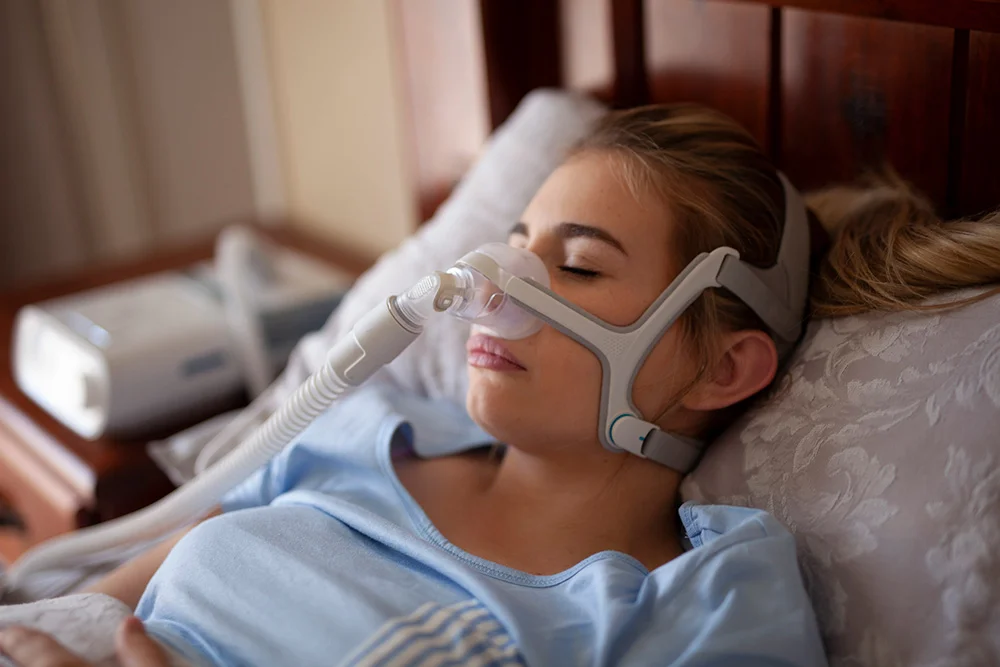
If you’ve used a CPAP machine for Obstructive Sleep Apnea (OSA) or another condition, you know the struggle well — you are supposed to breathe through your nose, but your nose is stuffed up. After all, allergies, sinus infections, and even dry nose side effects from the machine itself can mess up your best intentions with your CPAP. Researchers have been considering various solutions for this issue, to help improve compliance and comfort for those using CPAP machines.
A recent study published in the Journal of Sleep Medicine found that the use of a once-daily intranasal oxymetazoline, such as Afrin, with fluticasone, a corticosteroid medication, improved positive airway pressure (PAP) use and outcomes in patients with allergic rhinitis. They share the story of a participant, a 62-year-old male with OSA who had been struggling with his CPAP machine for 10 years. Intranasal fluticasone alone did not result in tolerance of PAP therapy, researchers noted. However, the combination of once-daily intranasal oxymetazoline with fluticasone led to “significant improvement in tolerance and adherence to PAP therapy.”
Researchers also pointed out that some studies have shown that using intranasal oxymetazoline along with an intranasal steroid once daily for four weeks helped relieve nasal symptoms without “rebound congestion” or “rhinitis medicamentosa,” which can come from overusing nasal spray. So, as with any remedy, it’s a fine line balancing helpful medications and ones that exacerbate the issue.
This isn’t the first time researchers have studied the impact of nasal sprays on CPAP patients. A 2021 study found that the use of an intranasal steroid improved the overall CPAP use in patients across 90 days. (1) Another 2021 study found that patients with OSA who used intranasal fluticasone had improved sleep quality. (2)
But some patients might find themselves wondering why the nose is so important to OSA treatment anyway? Especially when it’s clogged and they are trying to find comfortable solutions. Mayo Clinic shares that one of the causes of a dry nose during CPAP use is due to a leaky mask, and remedying that can improve your nasal congestion or dryness. Just like some people use a humidifier in the winter to offset dry air with moist, warmer air, there are also CPAP heated humidifiers that people sometimes try to improve nasal congestion or discomfort. But, talk to your sleep doctor first.
If your CPAP machine continues to bother you, you can look into other OSA options, and also hold out hope for the future of treating this widespread condition. There are currently medications in development for sleep apnea, and there are plenty of non-CPAP treatment options on the market right now. But, as some frustrated users and experts have shared, if we want people to use their CPAP machines, they need to be easier to use.
Sources
1. Segsarnviriya C, Chumthong R, Mahakit P. Effects of intranasal steroids on continuous positive airway pressure compliance among patients with obstructive sleep apnea. Sleep Breath. 2021 Sep;25(3):1293-1299. doi: 10.1007/s11325-020-02236-5. Epub 2020 Oct 26. PMID: 33104981.
2. Yuan-Yun Tam, I-Hung Shao, Chia-Chen Wu, Ming-Li Hsieh,
The impact of intranasal fluticasone on patients with obstructive sleep apnea: a prospective study, Brazilian Journal of Otorhinolaryngology, Volume 87, Issue 2, 2021, Pages 152-156, ISSN 1808-8694, https://doi.org/10.1016/j.bjorl.2019.07.007.

























